The Learning Environment for Developing Creativity of Undergraduates in Faculty of Management Sciences, Yala Rajabhat University
Main Article Content
Abstract
The learning environment to develop creativity of learners is crucial factor for learning-teaching arrangement which aims to produce qualified graduates with necessary skills for 21st Century. The objectives of this research were 1) to study the learning environments for developing the creativity, 2) to compare the learning environments for developing the creativity, according to major and year of study, and 3) to explore the learning management guideline for a creativity development. The concept of mixed method was applied to conduct a research. The 5-point Likert scale questionnaire was used to collect data from 475 undergraduate students from Faculty of Management Sciences, Yala Rajabhat University by using convenience sampling technique. In addition, in-depth interview and focus group were also used to gather qualitative data from 7 students to determine the learning management guideline to develop learner creativity. Statistics used for data analysis were frequency, percentage, mean, standard deviation, and one-way ANOVA. The results indicated that 1) most participants had demands on physical environment, learning climate, and learner engagement at the high level, 2) students from different year and major of study had different opinions on learning environment that support a creativity and 3) physical environments supporting creative activities, learning climate with individual differences focus and no right-wrong, motivating instructor or co-learner, group assignment, and question-answer session were important issues for managing learning environment to support a creativity of learners.
Article Details
References
กิ่งกาญจน์ โสภณพิศุตม์. (2561). การศึกษาแนวทางการปรับปรุงห้องเรียนสถาปัตยกรรมภายในกรณีศึกษา: คณะสถาปัตยกรรมศาสตร์ผังเมืองและนฤมิตศิลป์. วารสารวิชาการคณะสถาปัตยกรรมศาสตร์ สจล. 26 (1), 200-216.
กองบริการการศึกษา มหาวิทยาลัยราชภัฏยะลา. (2563). สถิติจำนวนนักศึกษาที่ลงทะเบียน ประจำปีการศึกษา 2563. ออนไลน์. สืบค้นเมื่อ 6 กุมภาพันธ์ 2564. แหล่งที่มา http://eduservice. yru.ac.th/newweb/page/mis/studentregyear.php?type=2563
วิจารณ์ พานิช. (2555). วิถีสร้างการเรียนรู้เพื่อศิษย์ในศตวรรษที่ 21. กรุงเทพมหานคร: มูลนิธิสดศรี-สฤษดิ์วงศ์.
สิริชัย ดีเลิศ, ปานใจ ธารทัศนวงศ์ และ สมนึก เอื้อจิระพงษ์พันธ์. (2560). ความคิดสร้างสรรค์ของบัณฑิตในสถาบันการศึกษาระดับอุดมศึกษาที่มีอัตลักษณ์เชิงสร้างสรรค์. วารสารการจัดการ มหาวิทยาลัยวลัยลักษณ์. 6 (1), 16-25.
สุรเกียรติ ธาดาวัฒนาวิทย์. (2561). การศึกษาเปรียบเทียบการจัดการศึกษาของสถาบันอุดมศึกษาด้านอุตสาหกรรมบริการ : กรณีศึกษาประเทศสวิสเซอร์แลนด์และประเทศไทย. วารสารวิทยาลัยดุสิตธานี. 12 (1), 332-349.
สำนักงานสภาพัฒนาการเศรษฐกิจและสังคมแห่งชาติ. (2564). รายงานสรุปผลการดำเนินการตามยุทธศาสตร์ชาติ ประจำปี 2563. ออนไลน์. สืบค้นเมื่อ 15 กุมภาพันธ์ 2564. แหล่งที่มา: http://nscr.nesdc. go.th/wp-content/uploads/2021/02/NS-12_438-449.pdf
Amabile, T. M. (2012). Componential theory of creativity. Online. Retrieved April 26, 2020. From: http://www.hbs.edu/faculty/Publication%20Files/12-096.pdf
Hair, Jr. J. F., Black, B. B., Anderson, R. and Tatham, R. L. (2006). Multivariate Data Analysis. (6th ed.). New Jersey: Pearson Education.
Krejcie, R. V. and Morgan, D. W. (1970). Determining Sample Size for Research Activities. Educational and Psychological measurement. 30, 607-610.
Richardson, C. and Michra, P. (2018). Learning Environment that Support Student Creativity: Developing the SCALE. Thinking Skills and Creativity. 27, 45-54.


